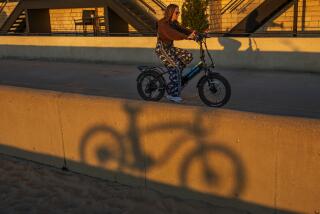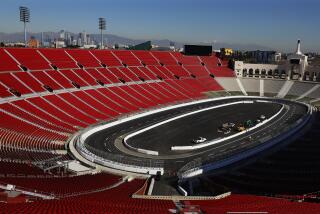Even now, the great escape
TODAY the sleepy town of Avalon is known more for yachts and margaritas than for full-throttle motorcycle racing.
In the ‘50s, though, it was a different — and much louder — story. Once a year a huge barge packed with racing motorcycles crossed the Catalina channel for the high point of the racing season: the Catalina Grand Prix.
For one weekend the roar of barely muffled engines blew Avalon’s seaside serenity into tiny, internally combusted shards. Hundreds of riders battled for position at the start of each race, counter-steering their sliding machines up into the hills through the sycamores and eucalyptus, dodging rocks, ruts and buffalo on the cliff-side dirt roads. The racers then plummeted back through town to the finish line on their booming Triumphs, Matchlesses and BSAs, the sidewalks packed with screaming fans.
The Catalina Grand Prix was one of the most important motorcycle races in America. Which is no surprise, considering that motorcycling and motorcycle racing have been part of the eclectic history and restless culture of Los Angeles since the first Indian rolled off the production line in 1901.
The first American motorcycles were built elsewhere: Indians in Springfield, Mass.; Harleys in Milwaukee. But it didn’t take long for them to arrive and thrive in the land of sun, sand and speedways. L.A.’s unique combination of perfect weather, wide-open spaces and rebellious spirit have combined, over the last 105 years, to make the area the center of the motorcycling universe.
In the 1910s, ‘20s and ‘30s, Los Angeles was a hotbed of board-track motorcycle racing. The first Los Angeles Coliseum was a motorcycle racetrack, a high-banked wooden velodrome. It was followed by board tracks in Playa del Rey, and even Beverly Hills. But it was after World War ll that motorcycling as a sport, and a way of life, took off in L.A.
It’s as if the place was built for riding. What other city has a twisting, swooping racetrack like Mulholland Drive running along its spine? Endless stretches of desert just an hour from City Hall, where you can ride until you run out of gas, stamina or both? An octopus of canyon roads in Malibu, high above the Pacific, that add up to a street-bike-riding theme park? And a broad-shouldered, big-sky landscape that seems to seduce a rider right into the sea?
Los Angeles has always represented a world of unlimited possibilities, of ultimate freedom. At the end of Route 66, the Great American Road, waited a freshly minted kind of America — and riding a motorcycle in Los Angeles, well, that was liberty writ louder, freedom squared. Former pilots and tank drivers and PT-boat skippers took their GI benefits and bought cheap, war-surplus Harley-Davidsons and Indians. The area was still largely unpaved, and the roar of your engine evoked the thundering radial power plants that pushed Hellcats and P-47s through the skies.
These GIs soon made these bikes their own. Many had seen lighter, more nimble Triumphs and BSAs in England, and some wanted their Harleys and Indians to have the same bare, stripped-down look and feel. So the bobber was invented. An owner simply took off the extra bits — fenders, windshield, passenger seat — anything that wasn’t the pure essence of tough-guy motorcycle. The $100,000 choppers of today, favored by wealthy enthusiasts and sports stars from Arnold S. to Shaquille O., are the direct descendants of those first bobbed machines. Jesse James, one of the most influential designers of the chopper phenomenon, today holds court in his 250,000-square-foot Long Beach compound.
L.A. is not just the spiritual home of American motorcycling, it’s the literal home as well. Ever since Honda set up its first office in 1959 on West Pico, motorcycle makers have made SoCal the nerve center of design and marketing for the motorcycling world. Honda motorcycles are often styled and designed in Torrance, at Honda’s R&D Americas facility, and tested out in the desert, on a private, high-speed test track in tiny Cantil, a wide spot on the road to Mammoth.
The motorcycle press has followed the industry — nearly every major American motorcycle publication has its headquarters in Los Angeles or Orange counties. New models are tested on our freeways, in our mountains, on our city streets. Which means that the unique characteristics of Los Angeles have forged the shape of many of the most significant machines.
The brilliant 1969 Honda CB750, which began the era of the high-speed, four-cylinder bikes known as the UJMs — Universal Japanese Motorcycles — was not designed for cramped, crowded Japan. It was designed for the wide streets, expansive freeways and sweeping corners of L.A. And, by extension, for the America that lay sprawled to the East, which was becoming more and more like L.A. with every passing day.
Sportbikes — fast, roadracing-style machines like Ducatis, Kawasaki Ninjas and Suzuki GSX-Rs — are built to go around corners. Milwaukee has a distinct shortage of canyon roads or mountain passes — which is why most Harleys are better suited for the straightaways than hairpin turns.
The Malibu Mountains, though, are a perfect proving ground for lightweight, high-powered road missiles, and any sunny afternoon will find the latest machines being evaluated up on Stunt Road, or down Latigo Canyon, or along Mulholland Highway.
Bud Ekins, who won the Catalina Grand Prix, describes growing up here, in the late 1940s, as living in motorcycle heaven. He would ride his stripped-down Triumph from his family’s Hollywood home, sliding along dusty fire roads and Mulholland Drive, ranging out to the sea through the canyons of the Santa Monica Mountains. In town, with little traffic to slow him down, he could slice through Los Angeles like a shark through sardines.
It was a Tom-Sawyer-on-two-wheels existence, racing around the city as if he owned the place. What Ekins learned with his constant, restless riding served him well. He became a legendary racer, motorcycle collector and stunt man — he did the climactic jump in “The Great Escape,” doubling for his good friend Steve McQueen.
Those days are gone — at least as far as riding like an escaped mustang through the dirt roads of the Hollywood Hills.
But even now, with the freeways choked nearly to a standstill, motorcyclists still own the place. California is the only state that allows lane-splitting — motorcycles threading their way between lanes of slower traffic. And after you escape the freeways and get your leathered self up into the canyons or the mountains, you can leave yourself behind as well.
Time slows and your pulse quickens. The sky is bluer, the sea is greener, the air is cooler. It’s the here and now, baby. Actually, it’s the there and now, because at these speeds, there’s no such thing as here.
More to Read
Start your day right
Sign up for Essential California for news, features and recommendations from the L.A. Times and beyond in your inbox six days a week.
You may occasionally receive promotional content from the Los Angeles Times.








